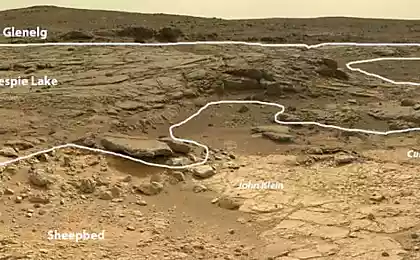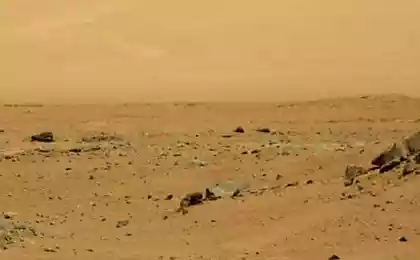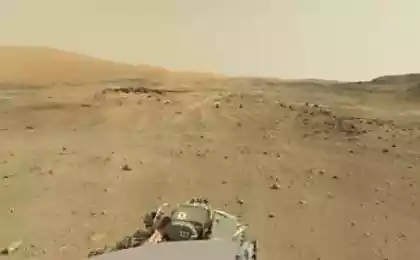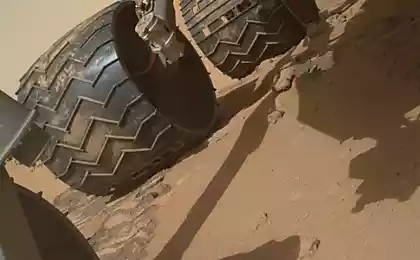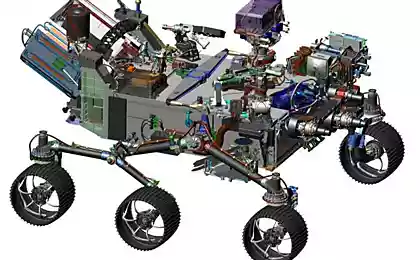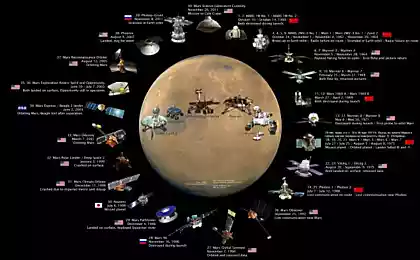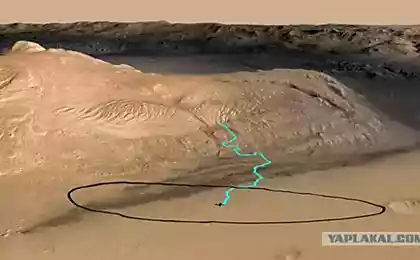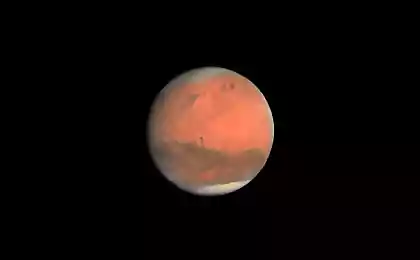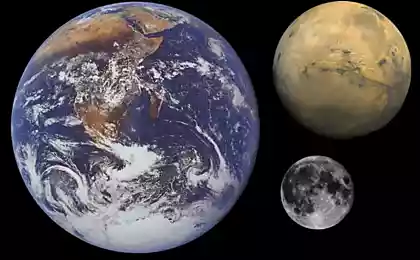1217
Mars Rover Curiosity: fun has just begun
A couple of weeks ago, NASA officials have extended financing expeditions Curiosity, but expressed the claim that the rover travels too much and not enough studying. The day before yesterday scientific team said, "but we have already come!". True, many journalists have understood them literally: that everything came the goal is achieved, but really only the rover starts its basic research program for which it and send.
More than a year Curiosity drove along the mountain Sharpe circling black sand piles at the foot, and picking up the more promising from the point of view of science areas. As a benchmark chosen conditional entry point from which it was planned to move to storm the mountain. Suddenly rough terrain and hard stones along the way led to increased wear of the wheels, so the rover had to move slowly, carefully choosing the route, circling dangerous placers.
It has been two Earth years - as much as was given to the entire mission, and goals - Mount Sharp, and even point of entry - were still far away. But the protracted scamper brought results - Curiosity got to ravines, at the bottom who expect rock that had not previously met. In addition, the bottom of the ravine beckoned soft sand, on which one could travel safely to the wheels.
The rover rushed to conquer ravine Hidden Walley, but threw sand surprises. Those dunes, which met earlier on the way, and that carpet the bottom of the ravine, actually consist of sand and finer fractions of that American geologists call silt, and our "silt" - a transitional form between sand and dust. Mechanical properties Mars silt most similar to cement or cocoa powder. The rover was tested in the desert, but in ordinary sand, so the behavior on such a surface on Mars was unstable.
Dunes were profound. Although Curiosity in them drowned and elm, the movement of the dunes found unpredictable and dangerous.
The rover has handed back, and on the way back found a curious light breeds, called Bonanza King - the term the gold rush, indicating a rich lode.
Along the way, was filmed another Martian solar eclipse:
Curiosity readied for drilling. Check the stability of his position, attached to the rock drill.
Note the push that occurs after touching the ground two stops. This rover simulates the load that is required drills.
The next test was to vibration.
The test result showed that the rock is too loose, and a well chosen unsuccessfully. From this idea was abandoned and leave the Hidden Walley. At the same time, Bonanza King did not disappoint. Analysis ChemCam spectrometer showed high content of silicon, with a concentration in which practically does not occur during the study of Mars.
In the picture you can see the result of the work of two tools: the right of the laser markings ChemCam, and the trace of the brush on the left DRT.
More silica found only Spirit, when unearthed deposition of pure silica in the form of white sand.
Bonanza King had to leave. Going round the side and looking around as follows Curiosity choose a new target in the ravines, and again moved forward fearlessly. At this time, the hollow called Amargosa Walley. It is much more spacious and not all blocked by the dunes, so you can pass.
And then the 360-degree spherical panorama entrance of Amargosa Walley, collected and processed fotohodozhnikom Andrew Bodrov (clickable screen, better open a new tab):
The purpose of the study called for Pahrump Hills. It is a light output of the reservoir rock. It is expected that there will be found more silicon.
Planetary crust that of Earth, Mars is largely composed of silicon, so there is not much interested in himself, as his concentration. It is believed that in the enrichment of silicon breed significant role played water. In addition, the crystalline form of silicon found will tell you more about the tectonic history of Mars, about how to form the crust of the planet. Previous rovers were unable crystallographic studies.
After Pahrump Hills NASA scientists decided to change the route, forget about the previously planned entry point, and move immediately to the mountain. Just a few days ago, I thought: "That would not scientists Curiosity drove back to the shore, and has moved to the mountain ravines ..." And please: a dream come true. At the same time saved kilometer.
Ahead of expected a lot of interesting things:
six-meter mesas Murray Buttes;
ancient surface Murray Formation, which still remembers the asteroid strike that gave birth to the Gale Crater, and other times hitting тяжелой bombardment ;
hypnotic in its blackness, sand dunes, long time not to let the rover to the mountain;
hematite ridge , which may be the remains of an ancient river, which is home to (possibly) chemolithotrophic bacteria;
clay deposits that could save the organics;
deep canyon, washed with glacial water in sulfate deposits, are not interesting from the point of view of astrobiology as part of artistic photography;
and finally, the deposition boxwork, at an altitude of 800 meters from the foot, which may be parched and stony bottom of the Gulf, once filled the crater Gale.
Now this is considered boxwork finish route point Curiosity, but if he can get there, and whether there will be there forever, now we can not say. We'll see.
See more possible through the official Twitter or zelenyikotovy a >. i>
Source: habrahabr.ru/post/236659/
More than a year Curiosity drove along the mountain Sharpe circling black sand piles at the foot, and picking up the more promising from the point of view of science areas. As a benchmark chosen conditional entry point from which it was planned to move to storm the mountain. Suddenly rough terrain and hard stones along the way led to increased wear of the wheels, so the rover had to move slowly, carefully choosing the route, circling dangerous placers.
It has been two Earth years - as much as was given to the entire mission, and goals - Mount Sharp, and even point of entry - were still far away. But the protracted scamper brought results - Curiosity got to ravines, at the bottom who expect rock that had not previously met. In addition, the bottom of the ravine beckoned soft sand, on which one could travel safely to the wheels.
The rover rushed to conquer ravine Hidden Walley, but threw sand surprises. Those dunes, which met earlier on the way, and that carpet the bottom of the ravine, actually consist of sand and finer fractions of that American geologists call silt, and our "silt" - a transitional form between sand and dust. Mechanical properties Mars silt most similar to cement or cocoa powder. The rover was tested in the desert, but in ordinary sand, so the behavior on such a surface on Mars was unstable.
Dunes were profound. Although Curiosity in them drowned and elm, the movement of the dunes found unpredictable and dangerous.
The rover has handed back, and on the way back found a curious light breeds, called Bonanza King - the term the gold rush, indicating a rich lode.
Along the way, was filmed another Martian solar eclipse:
Curiosity readied for drilling. Check the stability of his position, attached to the rock drill.
Note the push that occurs after touching the ground two stops. This rover simulates the load that is required drills.
The next test was to vibration.
The test result showed that the rock is too loose, and a well chosen unsuccessfully. From this idea was abandoned and leave the Hidden Walley. At the same time, Bonanza King did not disappoint. Analysis ChemCam spectrometer showed high content of silicon, with a concentration in which practically does not occur during the study of Mars.
In the picture you can see the result of the work of two tools: the right of the laser markings ChemCam, and the trace of the brush on the left DRT.
More silica found only Spirit, when unearthed deposition of pure silica in the form of white sand.
Bonanza King had to leave. Going round the side and looking around as follows Curiosity choose a new target in the ravines, and again moved forward fearlessly. At this time, the hollow called Amargosa Walley. It is much more spacious and not all blocked by the dunes, so you can pass.
And then the 360-degree spherical panorama entrance of Amargosa Walley, collected and processed fotohodozhnikom Andrew Bodrov (clickable screen, better open a new tab):
The purpose of the study called for Pahrump Hills. It is a light output of the reservoir rock. It is expected that there will be found more silicon.
Planetary crust that of Earth, Mars is largely composed of silicon, so there is not much interested in himself, as his concentration. It is believed that in the enrichment of silicon breed significant role played water. In addition, the crystalline form of silicon found will tell you more about the tectonic history of Mars, about how to form the crust of the planet. Previous rovers were unable crystallographic studies.
After Pahrump Hills NASA scientists decided to change the route, forget about the previously planned entry point, and move immediately to the mountain. Just a few days ago, I thought: "That would not scientists Curiosity drove back to the shore, and has moved to the mountain ravines ..." And please: a dream come true. At the same time saved kilometer.
Ahead of expected a lot of interesting things:
six-meter mesas Murray Buttes;
ancient surface Murray Formation, which still remembers the asteroid strike that gave birth to the Gale Crater, and other times hitting тяжелой bombardment ;
hypnotic in its blackness, sand dunes, long time not to let the rover to the mountain;
hematite ridge , which may be the remains of an ancient river, which is home to (possibly) chemolithotrophic bacteria;
clay deposits that could save the organics;
deep canyon, washed with glacial water in sulfate deposits, are not interesting from the point of view of astrobiology as part of artistic photography;
and finally, the deposition boxwork, at an altitude of 800 meters from the foot, which may be parched and stony bottom of the Gulf, once filled the crater Gale.
Now this is considered boxwork finish route point Curiosity, but if he can get there, and whether there will be there forever, now we can not say. We'll see.
See more possible through the official Twitter or zelenyikotovy a >. i>
Source: habrahabr.ru/post/236659/





